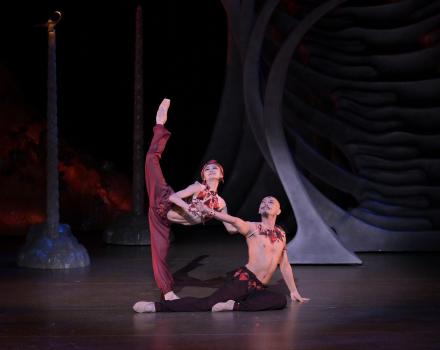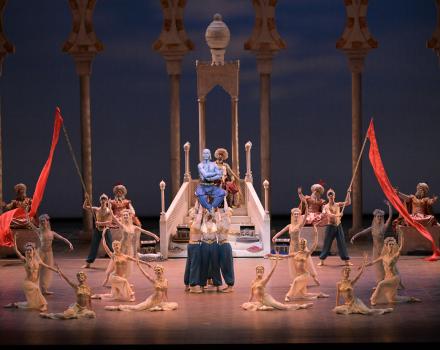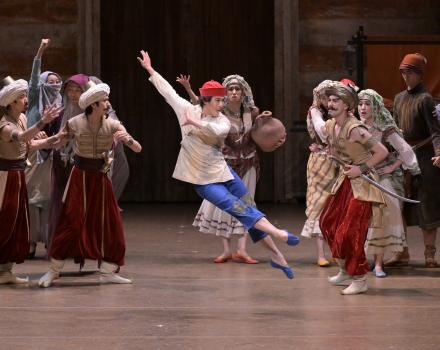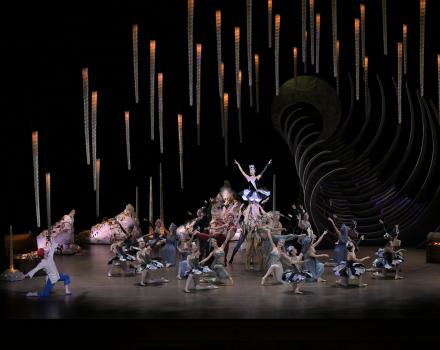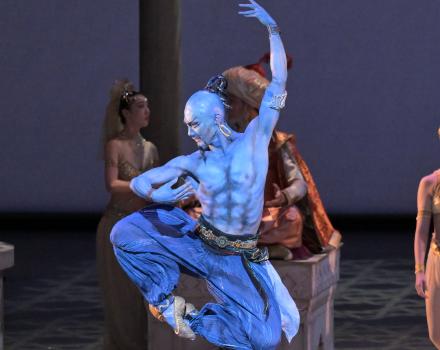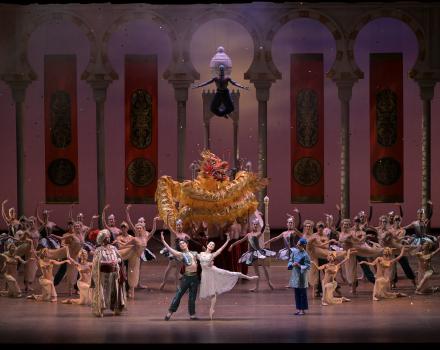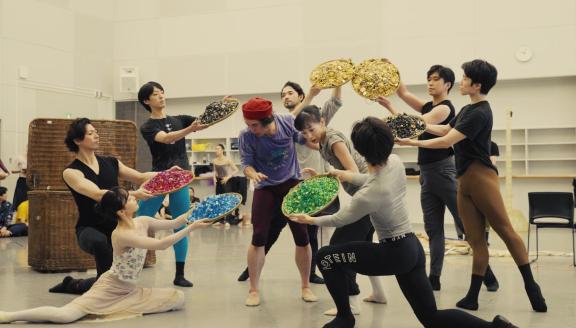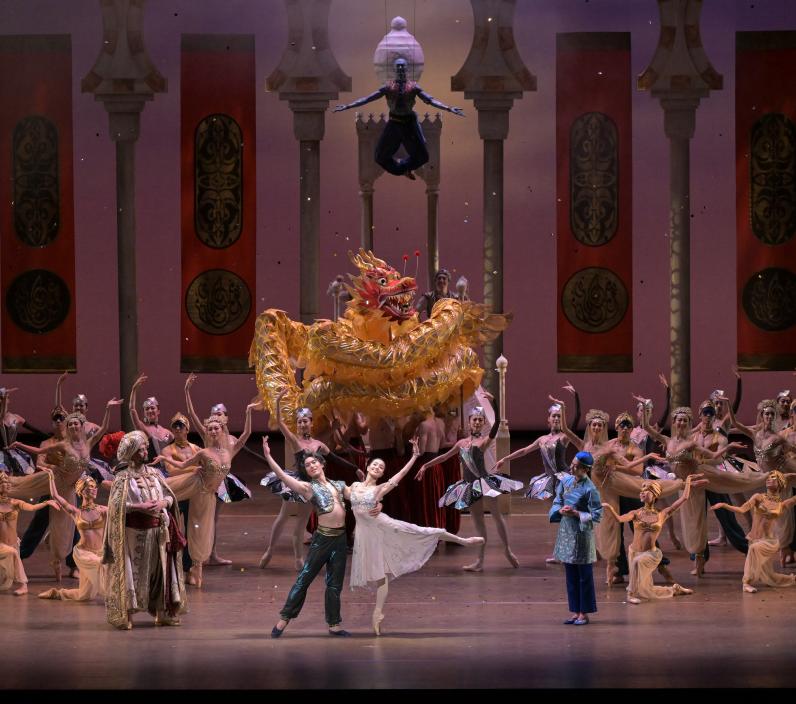
David Bintley's Aladdin

Much loved by children of all ages, Aladdin and his adventures are here brought to life in a glittering production, featuring lavish sets and costumes, stunning special effects and beautiful choreography. Expect extra magic when the Djinn of the Lamp appears from a cave of dancing jewels with a larger-than-life Chinese lion.
Created by David Bintley for the National Ballet of Japan in 2008, this production has been a favourite with Japanese audiences (this is the fourth revival), while also winning a place in the repertoire of Birmingham Royal Ballet and Houston Ballet. Bintley succeeds in presenting a familiar story with great clarity, whilst finding rich allusions to the nineteenth century classical form. It was Carl Davis’s score that convinced Bintley – listening on a single car journey – to make this ballet. The music captivates throughout, detailed in its description of the scènes d’action and lusciously romantic for the pas de deux. While it is widely recognized as an Arabian story, the tale of Aladdin in Arabian Nights is set in China. This production depicts him as a Chinese descendant in Old Arabia and beautifully incorporates Chinese elements including Lion and Dragon dances with settings inspired by the Arabian world. The stage designs by Dick Bird are magnificent, starting in a lively Arabian town square complete with fortune-tellers and merchants. Bintley, Bird and costume designer Sue Blane are much influenced by Chinese design, seen in the dragon and the palace interior. Aladdin and his mother’s clothes show that they are also Chinese, which helps to set the story at a cultural crossroads. With a magic carpet ride before the happy ending, David Bintley's Aladdin is a spectacle for whole-family viewing.
Cast
Aladdin | Yudai Fukuoka |
|---|---|
Princess Badr al-Budur | Ayako Ono |
The Maghrib | Masahiro Nakaya |
The Djinn of the Lamp | Takafumi Watanabe |
Aladdin’s Mother | Misato Nakada |
Princess’s Father, the Sultan | Shunya Nakajima |
Aladdin’s Friends | Yoshito Kinoshita Kenta Hara |
Desert Winds | Ai Kawaguchi Haruna Nakajima Yui Negishi Rui Tamai Momoka Hijikata Shanaya Kishiya Akiho Seki Hinako Tokunaga |
Onyx and Pearls | Moeko Iino Haruka Soutome Aoi Hirose Yu Onodera Kazuki Sano Hiroyuki Uka |
Gold and Silver | Atau Watanabe Naoko Asaeda Jaebum Cho Yuzaburo Shimizu |
Sapphire | Risako Ikeda Ai Kawaguchi Ayano Akai Momoka Hijikata Tomoko Kato |
Emeralds | Maiko Harada Yuko Masuda Mizuki Nakajima |
Rubies | Yuri Kimura Shun Izawa |
Diamond | Kasumi Okuda National Ballet of Japan |
Princess’s Attendants | Maiko Harada Ai Kawaguchi Yuko Masuda Yuzuki Hanagata Momoka Hijikata Tomoko Kato |
Guards, Djinn’s Entourage, Maghrib’s Harem, Dragon Dance | National Ballet of Japan |
Orchestra | Tokyo Philharmonic Orchestra |
| ... | |
Choreography | Sir David Bintley |
|---|---|
Music | Carl Davis |
Conductor | Paul Murphy |
Sets | Dick Bird |
Costumes | Sue Blane |
Lights | Mark Jonathan |
| ... | |
The performance of this work is licensed by Schott Music Co. Ltd., Tokyo on behalf of Faber Music LTD.
Video
Story
Prologue
The Maghrib, a magician from the East, stares longingly at a lamp that is just out of his reach.
Act I
A Souk in Old Arabia. Aladdin appears in the bustling market among the merchants and others. Always in some sort of trouble, he is pursued and caught by the palace guards. The Maghrib has been watching the unfolding situation and, using his magic powers, he rescues Aladdin and persuades the boy to perform a task for him. Aladdin, seeing easy riches within his grasp, agrees.
Journey to the Desert. A strong wind carries the two to the desert. The Maghrib tells Aladdin to descend into a cave and fetch a lamp that he has lost there. Aladdin grows fearful and when he tries to escape, the Maghrib stops him in his tracks by summoning the vision of an exquisite beauty and telling the boy that with the riches he discovers in the cave, he can make her his in own!
The Cave of Riches. Aladdin descends into the pitch black cave where he discovers a mountain of riches. Overjoyed with his find he begins to fill his pockets but then, remembering his task, searches for and finds the only lamp in the cave, a rather poor and dirty object. He returns to the entrance where the Maghrib refuses to let him out, demanding that ‘he first hand over the lamp!’ When Aladdin resists the Maghrib becomes angry and slams the door to the cave shut. Left in the dark cave, Aladdin searches desperately for a way out, but to no avail. It is then that he remembers that he still has the lamp.
Aladdin’s Home. Aladdin’s mother is worried sick about her son’s absence. Aladdin suddenly appears as if by magic and begins to relate all of his recent adventures. Hearing such a fantastic tale, his mother’s mood quickly changes and she scowls disbelievingly at him. Aladdin rubs the lamp and a Djinn appears, and with him all the wealth of the cave.
Outside the Imperial Palace. Fanfares can be heard from the marketplace as the Emperor’s daughter, princess Badr al-Budur, ‘Full moon of full moons’ is carried in a litter to the Imperial bathhouse. The crowds fall to their knees and cover their eyes as it is forbidden to gaze upon the Princess. Only Aladdin dares peek through his fingers and, seeing the Beauty from the Maghrib‘s vision, falls instantly in love with her.
Act II
The Bathhouse. The Princess Badr al-Budur is bathing in the bathhouse, unaware that Aladdin is watching her. When she notices his presence, Aladdin approaches her even though he is aware that capture would mean his certain death. Having led a life of daily routine and boredom, Aladdin’s bravado fascinates the Princess. Her fascination turns to horror when the palace guards burst in and drag Aladdin away.
The Royal Court. Aladdin is brought in chains before the Emperor, the Grand Vizier and the Court, for the crime of spying on the Princess. Despite a plea for clemency from Badr al-Budur herself, the boy is quickly found guilty and sentenced to die. At that moment Aladdin’s mother steps forward from the gallery to beg for her son’s mercy. The Court does not notice her slipping the marvellous lamp to Aladdin, who summons the Djinn, causing momentary chaos. When things calm down, standing before the Emperor is a handsomely attired young man. Amazingly this young man is Aladdin! He commands many slaves who offer the riches they are carrying to the Emperor. The Emperor then decides that Aladdin is a worthy suitor for the Princess and a joyous wedding ensues. Only the Grand Vizier, who is really the wicked Maghrib, does not join in the festivities. Having realised that Aladdin must have escaped from the cave and is now the master of the lamp, he schemes how to gain control of the Djinn for himself.
Act III
A Room in the Palace. Aladdin and the Princess are playing chess when friends come by and Aladdin excitedly joins them to go hunting. Later, from her window, the Princess hears an old beggar offering ‘New lamps for old’. Thinking only of how happy her husband will be to find that she has exchanged the grimy old lamp for a shiny new one, she gives the old lamp to the beggar who is actually the wicked Maghrib in disguise. Now at last he has control of the lamp and his first command of the Djinn is that he carries him and the Princess to the land of his home; Morocco.
The Maghrib’s Harem. The Maghrib imprisons the Princess and tells her to prepare herself to accept him as her new Lord and Master. Left alone the Princess grieves, fearful that she will never see Aladdin or freedom from the Maghrib’s harem again. In despair she is close to ending her life when Aladdin miraculously appears. Handing her a powerful sleeping drug, he instructs her to trick the Maghrib into drinking it. He then hides himself and waits. When the Maghrib returns, the Princess dances for him and feigns thirst at her exertions, whereupon the wicked sorcerer produces some liquor. When the concealed Aladdin momentarily distracts the Maghrib, the princess pours the drug into his drink, which he drinks to slake his thirst. Realising that something is amiss the Maghrib reaches for the lamp but Aladdin springs from his hiding place and prevents him from getting hold of it. A great struggle for possession of the lamp ensues but, as the Maghrib’s senses grow ever duller, Aladdin gains the upper hand and defeats him.
The Magic Carpet Ride. Aladdin and his Princess return home by way of a magic carpet ride provided by the Djinn.
Home Again. Aladdin and the Princess are reunited with their families. Aladdin, now rather wiser and more sensible, vows never to leave his Princess alone again. He releases the Djinn and Aladdin and his Princess are welcomed with blessings and joy by their people.
Insights
Interview with choreographer David Bintley
After a long time, Aladdin is coming back! Not only the dancers who have performed at the previous performances but also the dancers who are dancing for the first time are very much looking forward to the opportunity.
Me, too! I am also very happy to meet the dancers of the National Ballet of Japan again. It's been 16 years since I made it. I was just thinking about it on the way in, that it was a really good time, a really happy time for me. And it was also the time when I was first spoken to about directing the company at the New National Theatre Tokyo. It was also a crazy time. I just remember I had to work so quickly. A lot of things were coming at once. But it was really, really exciting! When you make a new piece, it doesn't occur to you until the opening night whether the audience will like it. But in Aladdin, everything just worked so well and the audience accepted it with enthusiasm. There are very few pieces that I make where I do not revise. I usually change substantially but for Aladdin, I didn't change anything from the premiere.
That proves the production has such a high level of perfection. I still remember very clearly the excitement I felt when I heard the overture on the first day. Every music brings back every scene in the production.
Yes! It's a great opening and it sets the scene. That was the style of the composer Carl Davis. He is an accomplished composer of cinematic music as well as concert music. He also knew a great deal about ballet. He is really professional and wrote music not only for many British ballet companies but also for the American companies. One day, he had given me the CD, the recording of the original Aladdin. To be honest, I wasn't interested in the subject at the time. I just thought I got to listen to it at least, so I put it in the car so that I could listen to it when I drove to the theatre, which took about an hour and a half. As I heard the music, it got me immediately, ‘Yes, I have to make it!’
There are a number of scenes that could be performed at a gala independently.
The story itself is light and not complicated, so I think the fun and the interest are in its stylistic beauty. There are various scenes, and you can enjoy various scenes and styles like an exposition. For example, in the cave scene in Act I, various jewels will appear, and I try to show different styles and techniques behind. Ruby is a kind of Soviet-style partnering giving a brilliant vibe. For the sapphire, something very soft, English dance or like...maybe Ashton. All of these different characters stand out, so you can enjoy the dance itself - and that is the fun, not the story. The story is very simple, but it also has depth. It is about the power of love against the domineering power. So it depicts that love is greater than dominence. When I made Aladdin, the company was not so used to making a new work. And I was not familiar with this company then. When I choreograph, I usually do not speak much. You do not sit down and talk to them about the characters and the piece itself, but you just have to make the steps and show them to make them understand. I am proud of Aladdin because it is very well made. Whether you like it or not, I am very proud of it.
After working with you, I think there has been a change in the dancers of the company. During the interviews, many dancers started to speak out their thoughts with their own words.
Thank you and if so, I'm glad. I noticed when we first performed Carmina Burana at the NNTT. I felt that Japanese dancers have very good things, so they need to put their inside out and put them on the performances as an expression. I was really lucky because I had top-level dancers who had an ability to do what I was looking for. When the top dancers set a good example the young dancers will follow them.
Different types of dancers are casted in the role of Aladdin and The Djinn of the Lamp. Even dancers who are not that tall were dancing Aladdin.
It is not necessary to be tall to dance the role of Aladdin. The tall dancers have many opportunities to dance with their partners and know how to lift, but Mr. Akimitsu Yahata, who was selected for the premiere, is not tall and has almost no experience in partnering. That's why it was a challenge, and it will expand the possibilities of the dancers. It is good for them. The dancers I choose are based on their talent rather than physical condition, so there may have been a surprising cast. In the case of a corps de ballet, the emphasis would be on being in good physical shape. But Aladdin is the main character, and he needs to be a star. Talent is more important than height.
Could you tell us about your thoughts on the performance?
I made the ballet for the National Ballet of Japan. Many roles casting many dancers. I also took it to Birmingham and also performed it at the Houston Ballet, but, for me, they were not the same. Aladdin is, after all, a work created here for the National Ballet of Japan. It was embraced by them and I am just thrilled and delighted that it goes from generation to generation. And I made it for the audience to delight them, make them enjoy, think, and laugh. Ballet will take you away from the world. I am so delighted that the company is doing Aladdin again and hope you enjoy it.
Extract from New National Theatre Tokyo's Friends Magazine 'The Atre' (April 2024 issue)
Gallery
